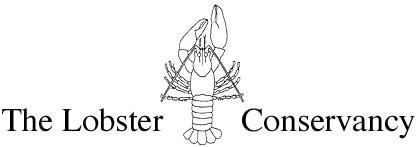
P.O. Box 235, Friendship, ME 04547 (207) 832-8224 www.lobsters.org

P.O. Box 235, Friendship, ME 04547 (207) 832-8224 www.lobsters.org
1 November 1998
Dear Volunteers and Friends of The Lobster Conservancy,
There is so much news this October that it's hard to know where to begin! October marks the end of the sampling season for many of the volunteers. Soon, it will be time for the 1998 evaluations and discussions of your experiences. Meanwhile, thank you for completing your October surveys and getting your data to us in a timely manner.News from the Board of Directors
Diane has accepted the position of "Marine Scientist IV, Division of Biological Monitoring" at the Maine Department of Marine Resources. Her job will be to act as the state's senior lobster scientist and to oversee the state's lobster, sea urchin, herring and shrimp biological monitoring programs. In addition to developing and directing scientific programs, she will serve as an advisor to the Commissioner and Deputy Commissioner of DMR as well as to other state agencies such as the Department of Environmental Protection and State Planning Office. Diane will need to devote the bulk of her time to this new job, which starts on November 9, 1998.
 Sara Ellis holds a lobster caught in a quadrat along the transect sampled on the east side of Barleyfield Point at Lowell's Cove. Photo by Diane Cowan. |
The Lobster Conservancy welcomes Sara Lynn Ellis, Ph.D, who will be taking over the day to day operations and working with the volunteers next year. Sara is a highly intelligent and dedicated scientist who brings new perspectives and skills to TLC. Diane plans to remain a member of the board and will work closely with Sara.
Meanwhile, the members of the board are in the midst of making a decision regarding whether to accept a significant donation of property. Of course, we want to say yes. We are in the process of investigating our financial ability to insure and pay taxes on what we hope will be our new headquarters, lab and field site in Friendship, Maine. (See July News for background) |
The Lobster Conservancy has appealed a Department of Environmental Protection permit to partially fill the freshwater wetland the drains into Lowell's Cove. The Board of Environmental Protection (BEP will hear the appeal on Wednesday, December 16. All comments must be received by the BEP before November 16. Write or call if you are interested in details.
Tagging Studies
In October, sampling effort was split between Harpswell and Penobscot Bay. The effort at Lowell's Cove was therefore decreased by half. In two days of sampling 120 lobsters were marked using coded wire tags and 17 previously tagged lobsters were recaptured.
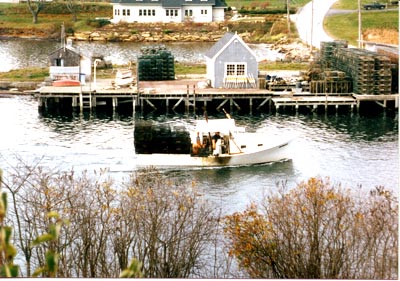 Colby College student, John Kurucz, holds a hand full of young-of-the-year lobsters caught in a quadrat along the transect sampled on the west side of Barleyfield Point at Lowell's Cove. Photo by Diane Cowan. |
Another settlement event occurred at Lowell's Cove where the west side of Barleyfield Point yielded the highest density of young-of-the-year recorded in many years. Colby College student, John Kurucz, who joined Diane on October 7, witnessed the event. Thanks for your help, John. |
Harpswell Volunteers
 Keith Bisson records data on a clipboard along the shoreline at Cedar Beach. Photo by Diane Cowan. |
Sampling in Harpswell continues routinely. The volunteers are well-trained and dedicated. The only concern here is the observation (at a minimum of two Harpswell sites) that freshwater wetlands draining into the lobster nurseries are being altered by the placement of fill and cutting of wetland vegetation. These observations are startling and bring home the importance of our monitoring -- not only for the sake of recording lobster abundance, but, perhaps more importantly, to record how habitat degradation relates to lobster abundance. Harpswell's lobster nurseries sit in a precarious position. Be vigilant and do your best to protect them. |
| The highlight this month was Diane's trip to the Osolin's site on Jaquish Island on October 5th. Kristine Osolin identified the site this spring and trained her parents Ned and Kathy in the fine art of quadrat sampling, catching, measuring and releasing juvenile lobsters. The site is wonderful and highly productive. We found many recently settled and larger juveniles. Congratulations on your achievements and family-team effort! | 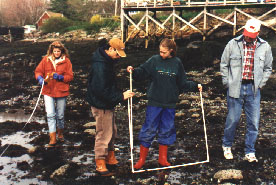 Kristine Osolin breaks down the quadrat and Amy Watson rolls up the transect while Eric and John Cobbs look on after an afternoon of sampling at Cundy's Harbor. Photo by Diane Cowan. |
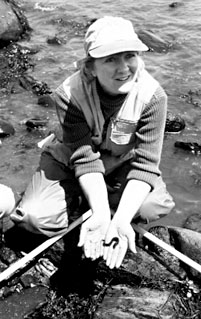 Diane Cowan shows the Pen Bay Volunteers a rock gunnel she found during a training session at Moose Point State Park. Photo by Spiros Polemies. |
Low tide on October 4, was spent searching the shoreline of Stonington, Deer Isle, in an attempt to train Downeast volunteers in the skill of sampling juvenile lobsters in the lower intertidal zone. Eight of us met in Sunshine, at the house of Leroy Bridges (President of the Downeast Lobstermen's Association). Although the level of interest was high, the weather highly cooperative, and the area covered vast, we failed to uncover a single lobster. Participants will spread out and continue the search next year.
For the morning tide on October 8, effort was turned to the western shores of the Penobscot Bay Region on Allen Island off Port Clyde. Allen Island may prove to be as productive as Drift Inn Beach (on the mainland) -- or, even, Lowell's Cove. This site also represents the type of collaboration that can be born out of the Pen Bay Project. The site was discovered and recognized as a likely candidate for a lobster nursery by Philip Conkling (Executive Director of the Island Institute) on a field trip with students. |
| Diane immediately found a young-of-the-year near the dock where we disembarked on Allen Island. Reluctantly, we passed the productive looking cove by, on the way to the other side of the island where we searched adjacent to Carl Wilson's subtidal sampling site. After finding nothing there, we (Diane Cowan, Philip Conkling, Carl Wilson and Bob Steneck's interns working at the University of Maine's Darling Center) turned our attention back to the site where Philip had been before. There, although the tide had been flooding for more than one hour, we collected, measured and recorded characteristics of the abundant juvenile lobsters. We are thrilled with this achievement and look forward to training reliable volunteers who can continue sampling -- and, perhaps even implement a mark and recapture study -- at Allen Island. | 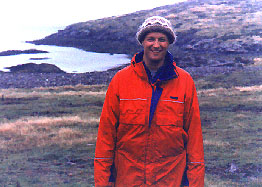 Carl Wilson stands in the rain at Allen Island. Photo by Diane Cowan. |
The evening tide of October 8 was spent on Vinalhaven with a group of extremely dedicated volunteers happy to go out in the rain under the cover of nightfall. Although juvenile lobsters were found at Lane's Island Beach, the abundance there is low and the smallest animal found was 17 mm CL. Next year, the Vinalhaven volunteers will attempt to identify other, more productive sites in the area. Drift Inn Beach is the most productive survey site that has been identified thus far in the Pen Bay region. The volunteers trained at the site are reliable and have sampled for all three months. Jane Roundy and Julie Wortman have also chosen a sampling date for November. They have found young-of-the-year lobsters. The volunteers are sampling two sets of 10 one meter squared quadrats along fixed transects set on the rocky shore on either side of a sand/gravel beach.
Several sites have been searched at Spruce Head. On several occasions lobsters have been found at Waterman Beach. This may be a site worth monitoring long-term. However, a volunteer leader who is dedicated to the project needs to be identified for the site.PublicityCommunity Education
Invited Lectures
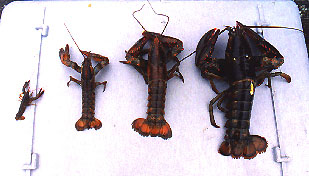 A one, two, three, and four-year-old lobster lined up for a photograph at Lowell's Cove. Photo by Diane Cowan. |
Diane gave three talks to three diverse audiences this month. The first was an appearance on the Estuary and Wading Bird panel at the Maine Coastal Programs Coastal Conference to celebrate the Year of the Ocean on October 9th. The message conveyed was that when citizens and regulators think about protecting estuaries and coastal wetlands they should be aware that they are preserving habitat for lobster. It is well-recognized that near-shore intertidal areas are important to clams and birds. It's time to recognize that many such areas also serve as critical lobster nurseries.
On October 19th, Diane led a discussion for Bates College students in Curtis Bohlen's wetlands course. Diane shared her experience in trying to understand the Department of Environmental Protection's permitting process and enforcement of regulations. In particular, the discussion centered around the Lowell's Cove appeal. |
On October 26th, Diane taught 8th grade students at the Bristol Consolidated School about the lobster life cycle and volunteer monitoring program. Students are working on projects related to fisheries management.
OutreachNote from the Executive Director
As I have let you know above, I begin working for the state this month. Due to my new position at DMR, there will be some upcoming changes in the board of TLC. However events may unfold, I will remain intimately involved in the direction of TLC. The board will notify you of further developments. I have greatly enjoyed and will surely miss dedicating myself solely to you.
Yours in TLC and Friendship,
Sara Ellis, Executive Director and Diane Cowan, Senior Scientist